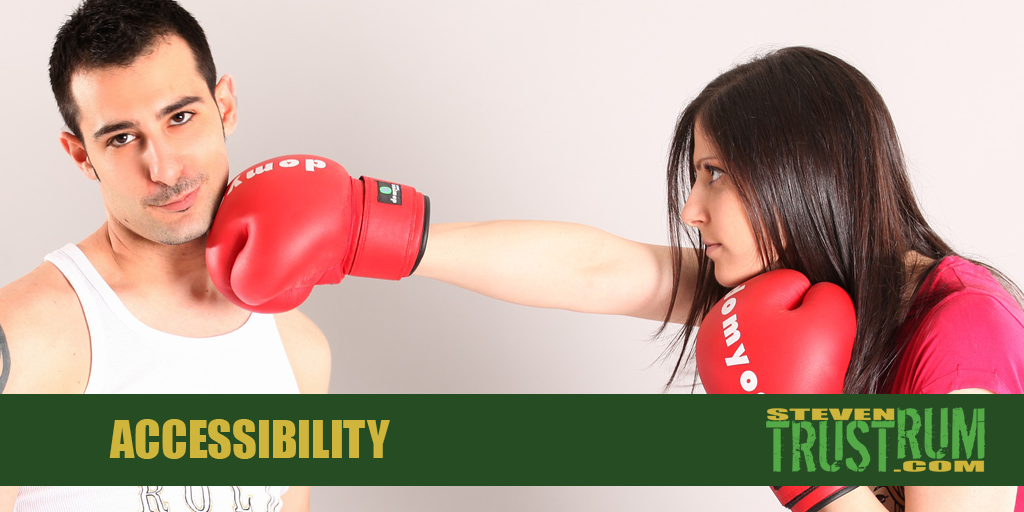SEO and Accessibility Can Work Together

SEO and accessibility are two different aspects of web design and content creation, both of which are still evolving. As they do so, companies are struggling to make SEO and accessibility work together in harmony. Such woes will become more prevalent as accessibility is increasingly regulated.
Arguably the most common misunderstanding is that SEO takes a beating from accessibility. Why? Because accessibility is about enhancing usability and message clarity, whereas SEO is about increasing visibility to online traffic. SEO and accessibility are therefore framed as an internal goal versus a user need (and perhaps government mandate.) Such framing unavoidably positions accessibility as the priority. But does it have to be this way?
No, it does not.
Why are SEO and Accessibility Thought to be at Odds?
One of the significant concerns regarding how SEO and accessibility won’t work together is the latter’s need for consistency. Some web content accessibility guidelines (WCAG) require consistent deployment for users with accessibility needs (e.g., screen readers) to know what to expect. For example, the two previous links both go to the same destination (the WCAG.) but use different link text. This is an accessibility defect (3.2.4 consistent identification) because the links both go to the same website but use different wording.
So, why is this a problem?
Consistency is Key — and an SEO Hurdle
Consider how much you take for granted, being able to use keyword phrases for internal and external links. Both are relevant and legitimate search engine optimization techniques for building authority. (External links especially for authority building.) But if accessibility requires consistent (although not necessarily identical) presentation and identification, how can this SEO technique remain useful?
Here’s a simple (if potentially time-consuming) approach to internal links: Build keyword-specific, isolated landing pages. This strategy lets you use keywords in links as desired so long as the link goes to that page. From this landing page, you can present a brief message specific to the keyword phrase. Next, add a call-to-action pointing to a preferred outcome. You can even change the call-to-action to suit current campaigns, so long as those links also remain consistent. This approach benefits SEO by providing another page to focus more intently on optimizing for a particular keyword phrase. The campaign’s exposure is elevated while also meeting accessibility needs.
(Links must be consistent so their purpose is predictable. Once a screen reader user encounters one link to the destination, they can quickly identify others that do the same.)
Links Must Be Self-Explanatory
Another issue that arises between SEO and accessibility is external links. Although consistent link text requires a bit of creativity, it’s not the only obstacle. There is another accessibility requirement that can serve as a hurdle. Link presentation must be consistent, but it must also be self-explanatory (2.4.4. link purpose in context.)
What a link does must be apparent from its design and its wording. Link text like “www.misfit-studios.com” is not accessible because I don’t know what the target site does unless I’m already familiar with the page. (Not that URLs are especially useful to SEO anyway, but you get the point.) The need for a link’s purpose to be self-explanatory (in context) means that most keyword phrases can be made accessible if they are pointing at an appropriate destination.
I would also suggest looking into how to hide content from the screen so your links provide additional information for screen readers. You must, for example, indicate when a link opens in a new window or browser tab. You don’t want this information to be visible, however. Instead, hide it so only screen readers present it.
Leverage Other SEO Benchmarks
Accessibility doesn’t affect all SEO benchmarks equally (or at all, in some cases.) Some accessibility compliance requirements can even create SEO opportunities. For example, using an image’s ALT element properly is a vital part of making informative images accessible. Needing to use ALT elements more effectively (and likely often) creates additional SEO opportunities. Additionally, page titles, meaningful URLs and headings, and proper use of semantic HTML elements (e.g., <strong>) elevate both SEO and accessibility.
Accessibility also aids SEO by enhancing usability. The more accessible a website is, the easier it necessarily becomes to understand and use. Accessibility elevates the entire user experience, potentially reducing bounce rates. As bounce rates go down, the site’s potential as an authoritative source on its subject matter increases. Such outcomes are undeniably beneficial to SEO efforts. Once again, we see SEO and accessibility working together. To know more about SEO, look for Victorious services, an SEO agency that leverages a wealth of performance data and market research to create scientifically-driven SEO strategies.
Why Making SEO and Accessibility Work Together is Critical
SEO and accessibility are both critical elements for a successful online presence, but for different reasons. As such, neither can be ignored to benefit the other.
Content creators must find creative ways to get SEO’s needs and accessibility to shake hands (especially if accessibility compliance is not optional.) I believe it is an inevitable matter of time before technology (including HTML and Aria) shifts even more significantly to accommodate this critical relationship. That day is not yet here, however.
Most of the work required by SEO and accessibility compatibility must be done at ground level until the tools at hand catch up at all levels. Meeting this need requires content creators to expand their skill sets to include accessibility. Also, content and web development teams must work more closely together to incorporate accessible SEO solutions into the site structure. The direction content creation is heading also makes dual subject matter experts in SEO and accessibility all the more valuable to successful content channels.
Are you ready? The future is SEO and accessibility working together as different sides of the same coin.

